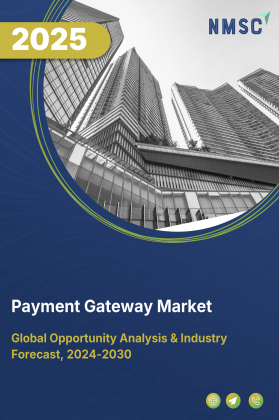
Payment Gateway Market by Type (Hosted Payment Gateways, Non-Hosted Payment Gateways, Integrated Payment Gateways and Others), by Deployment Model (On-Premises and Cloud-Based), by Enterprise Size (Large Enterprises, Small & Medium Enterprises), by Payment Method (Credit/Debit Cards, Bank Transfers, Wallets, BNPL, EMI and Others), and by End User (E-commerce & Retail, Travel & Hospitality, Media & Entertainment and Others) – Global Opportunity Analysis and Industry Forecast 2025-2030.
Industry Outlook
The global Payment Gateway Market size was valued at USD 42.68 billion in 2024, with an estimation of USD 52.40 billion in 2025 and is predicted to reach USD 146.28 billion by 2030 with a CAGR of 22.79% from 2025-2030.
The payment gateway market is expanding rapidly, driven by the explosive rise of e-commerce and mobile commerce. Secure, scalable gateways are essential to support seamless customer experiences across multiple channels. The growing adoption of real-time and mobile payments is accelerating demand, as consumers seek instant, secure, and convenient transactions.
At the same time, the integration of digital wallets and alternative payment methods like BNPL, UPI, and cryptocurrencies is reshaping consumer expectations, making diverse payment options a key growth driver.
However, the industry faces challenges from increasing fraud risks and stricter regulatory pressures, which demand continuous investment in compliance and security. On the other hand, the expansion of contactless and IoT-enabled payments opens new opportunities, with smart devices and tap-and-go transactions set to define the future of digital commerce.
Explosive Rise of E-Commerce Fuels the Payment Gateway Market Growth
The surging growth of e-commerce and mobile commerce continues to be a key driver of the payment gateway market. In 2024, U.S. e-commerce sales reached $1.192 trillion, reflecting the massive transaction volumes processed online.
As businesses expand digital storefronts, embrace personalization, and adopt customer-centric innovations, secure and scalable payment gateways become indispensable for managing payments, reducing friction, and ensuring seamless customer experiences across multiple channels.
Adoption Of Real-Time and Mobile Payments Drives the Payment Gateway Market Demand
The increasing adoption of real-time and mobile payments is a major driver of the market. With the growing use of smartphones and high internet penetration, consumers are shifting toward instant, on-the-go payment solutions that offer speed, convenience, and security.
Payment gateways play a critical role in enabling these transactions by integrating with real-time payment infrastructures and mobile apps, ensuring seamless fund transfers between customers and merchants. This trend is particularly strong in regions where governments and financial institutions are promoting real-time payment systems, such as UPI in India or RTP in the United States, further fuelling the demand for advanced payment gateway solutions.
Growing Integration of Digital Wallets and Alternative Payment Methods Boost the Payment Gateway Market Trends
The rapid adoption of digital wallets such as PayPal, Apple Pay, Google Pay, Phone Pe, and Alipay, along with alternative payment methods like Buy Now Pay Later (BNPL), UPI, and even cryptocurrencies, is significantly driving the market. Consumers increasingly expect fast, secure, and convenient checkout experiences, and merchants rely on payment gateways to provide these options seamlessly.
In regions with low credit card penetration, digital wallets and alternative payment systems are becoming the primary means of online and mobile transactions, boosting financial inclusion. As e-commerce and cross-border trade expand, the demand for gateways that support a wide range of payment options continues to rise, positioning integration of digital wallets and alternative methods as a key growth driver for the payment gateway industry.
Rising Fraud Risks and Regulatory Pressures Limits the Payment Gateway Market Expansion
The payment gateway market faces significant challenges from increasing fraud risks and tightening regulatory requirements. As digital transactions grow more complex, gateways are under constant pressure to combat evolving cyber threats and ensure secure processing.
At the same time, regulators across regions are enforcing stricter compliance standards, which demand continuous upgrades in infrastructure and reporting. Balancing the need for seamless, fast transactions with the obligation to maintain strong security and compliance has become a major restraint on market growth.
Expansion of Contactless and IoT Payments Creates New Growth Opportunities
The growing adoption of contactless payments and Internet of Things (IoT)-enabled transactions presents a significant opportunity for the payment gateway market. Consumers are increasingly embracing tap-and-go payments through NFC cards, mobile wallets, and wearables, driven by demand for speed, convenience, and hygiene.
At the same time, IoT is transforming the way payments are made, with connected devices such as smartwatches, voice assistants, and even connected cars enabling seamless, embedded transactions. Payment gateways that integrate with these technologies capture a new wave of digital commerce, positioning themselves at the center of future payment ecosystems. As IoT expands across retail, transportation, and smart cities, the demand for secure, real-time, and device-agnostic gateway solutions is expected to rise sharply, offering providers a substantial growth opportunity.
Market Segmentation and Scope of Study
The payment gateway market report is divided on the basis of type, deployment model, enterprise size, payment method, end user and region. On the basis of type, the market is grouped into hosted payment gateways, non-hosted payment gateways, integrated payment gateways, mobile payment gateways, and cryptocurrency payment gateways. On the basis of deployment model, the market is categorized into on-premises and cloud-based solutions. On the basis of enterprise size, the market is segmented into large enterprises, small & medium enterprises. On the basis of payment method, the market is grouped into credit/debit cards, wallets, EMIs, BNPL, and others. On the basis of end user, the market is categorized into e-commerce & retail, travel & hospitality, media & entertainment, healthcare, education, BFSI, and others. Regional breakdown and analysis of each of the aforesaid segments includes regions comprising of Asia-Pacific, North America, Europe, and RoW.
Geographical Analysis
In North America, the rapid expansion of e-commerce and the widespread use of digital wallets such as PayPal, Apple Pay, and Google Pay are major drivers of the payment gateway market. Consumers increasingly expect fast, secure, and flexible checkout experiences across both online and in-store channels.
Additionally, the region’s high credit and debit card penetration, coupled with rising demand for contactless and mobile-based payments, is boosting reliance on advanced payment gateways. With retailers, fintech companies, and banks integrating multiple payment options to meet consumer expectations, North America continues to represent one of the largest and most dynamic markets for online transaction processing providers.
Europe commands a substantial portion of the global market and is set to maintain robust expansion over the coming years. The euro area processed 72.1 billion non-cash payments worth USD 123,715 billion. With card and e-money transactions representing a significant share, payment gateways are essential in supporting interoperability, ensuring strong customer authentication, and meeting compliance requirements.
Although Europe’s market is currently dominated by card-based systems, the growing emphasis on digitalization and cross-border payments is expected to create new opportunities for gateways to deliver secure, efficient, and multi-currency transaction capabilities across the region.
The Asia Pacific market is the fastest expanding globally. The widespread use of digital wallets and mobile payment solutions is a key driver of the payment gateway market in Asia-Pacific. Consumers increasingly prefer convenient, fast, and secure mobile transactions over traditional payment methods, prompting businesses to adopt gateways that handle multiple mobile-first payment options. This trend encourages innovation in gateway services, including seamless integration with local payment systems, enhanced security features, and support for diverse payment methods, ultimately fuelling the expansion and modernization of the market across the region.
Moreover, the Rest of the World is witnessing increasing digital financial inclusion, which is driving demand for Payment gateway solutions. As more consumers and small businesses gain access to mobile banking, e-wallets, and online payment platforms, merchants are adopting gateways to support secure, convenient, and accessible transactions. This expansion of digital payment infrastructure across Latin America, the Middle East, and Africa encourages innovation in gateway services, including multi-currency support, mobile compatibility, and localized solutions, ultimately contributing to the growth and modernization of the market in these emerging regions.
Strategic Innovations Adopted by Key Players
Key players in payment gateway industry are accelerating global expansion through innovative product launches, service diversification, and strategic partnerships, aiming to enhance transaction security, support emerging payment methods, and cater to a growing base of digital merchants worldwide.
-
In July 2025, Stripe has significantly enhanced its fraud prevention capabilities by introducing an AI-driven foundation model, which has increased detection rates for attacks on large businesses by 64% overnight. The company also launched stablecoin account capabilities, enabling merchants to manage digital currencies alongside traditional payments. These innovations position Stripe at the forefront of secure and versatile payment solutions.
-
In May 2025, Global Payments has introduced the Genius™ for Retail solution, a comprehensive point-of-sale and Payment Gateway system designed to support small and medium-sized retail businesses. By integrating transaction processing, fraud prevention, and digital payment capabilities, the platform enhances merchant access to secure and seamless payment solutions. This initiative highlights Global Payments’ focus on expanding its digital payment solutions offerings, enabling businesses to handle diverse payment methods efficiently while strengthening the company’s presence and competitiveness in the global payment’s ecosystem.
-
In May 2025, Adyen has partnered with JCB to launch a new Card-on-File Tokenization service, designed to enhance payment security for eCommerce merchants. The initiative aims to reduce credit card fraud and improve authorization rates, offering businesses a safer and more reliable transaction process. This move positions Adyen as a leader in secure payment solutions, reinforcing its commitment to innovation and trust in the rapidly evolving global market.
Key Benefits
-
The report provides quantitative analysis and estimations of the payment gateway market from 2025 to 2030, that assists in identifying the prevailing market opportunities.
-
The study comprises a deep-dive analysis of the market including the current and future trends to depict prevalent investment pockets in the market.
-
Information related to key drivers, restraints, and opportunities and their impact on the payment gateway market is provided in the report.
-
Competitive analysis of the players, along with their market share is provided in the report.
-
SWOT analysis and Porters Five Forces model is elaborated in the study.
-
Value chain analysis in the market study provides a clear picture of roles of stakeholders
Payment Gateway Market Key Segments
By Type
-
Hosted Payment Gateways
-
Non-Hosted Payment Gateways
-
Integrated Payment Gateways
-
Mobile Payment Gateways
-
Cryptocurrency Payment Gateways
By Deployment Model
-
On-Premises
-
Cloud-Based
By Enterprise Size
-
Large Enterprises
-
SMEs
By Payment Method
-
Credit/Debit Cards
-
Bank Transfers
-
Net Banking
-
UPI
-
-
Wallets
-
Mobile
-
Digital
-
-
BNPL
-
EMI
-
Others
By End User
-
E-commerce & Retail
-
Travel & Hospitality
-
Media & Entertainment
-
Healthcare
-
Education
-
BFSI
-
Government & Public Sector
-
Telecommunications & Utilities
-
Logistics & Transportation
-
Gaming & Online Gambling
-
Non-Profit & Charities
-
Others
By Region
-
North America
-
The U.S
-
Canada
-
Mexico
-
-
Europe
-
The UK
-
Germany
-
France
-
Italy
-
Spain
-
Denmark
-
Netherlands
-
Finland
-
Sweden
-
Norway
-
Russia
-
Rest of Europe
-
-
Asia-Pacific
-
China
-
Japan
-
India
-
South Korea
-
Australia
-
Indonesia
-
Singapore
-
Taiwan
-
Thailand
-
Rest of Asia-Pacific
-
-
Rest of the World
-
Latin America
-
Middle East
-
Africa
-
Key Players
-
Stripe, Inc.
-
Worldpay, Inc.
-
Global Payments Inc.
-
Block, Inc.
-
Checkout.com Ltd
-
Fiserv, Inc.
-
Worldline SA
-
CyberSource
-
PayU
-
2Checkout
-
Rapyd Ltd
-
Paysafe Group Ltd
-
BlueSnap
Report Scope and Segmentation
|
Parameters |
Details |
|
Market Size in 2025 |
USD 52.40 Billion |
|
Revenue Forecast in 2030 |
USD 146.28 Billion |
|
Growth Rate |
CAGR of 22.79% from 2025 to 2030 |
|
Analysis Period |
2024–2030 |
|
Base Year Considered |
2024 |
|
Forecast Period |
2025–2030 |
|
Market Size Estimation |
Billion (USD) |
|
Growth Factors |
|
|
Countries Covered |
28 |
|
Companies Profiled |
15 |
|
Market Share |
Available for 10 companies |
|
Customization Scope |
Free customization (equivalent to up to 80 working hours of analysts) after purchase. Addition or alteration to country, regional, and segment scope. |
|
Pricing and Purchase Options |
Avail customized purchase options to meet your exact research needs. |

















 Speak to Our Analyst
Speak to Our Analyst






















